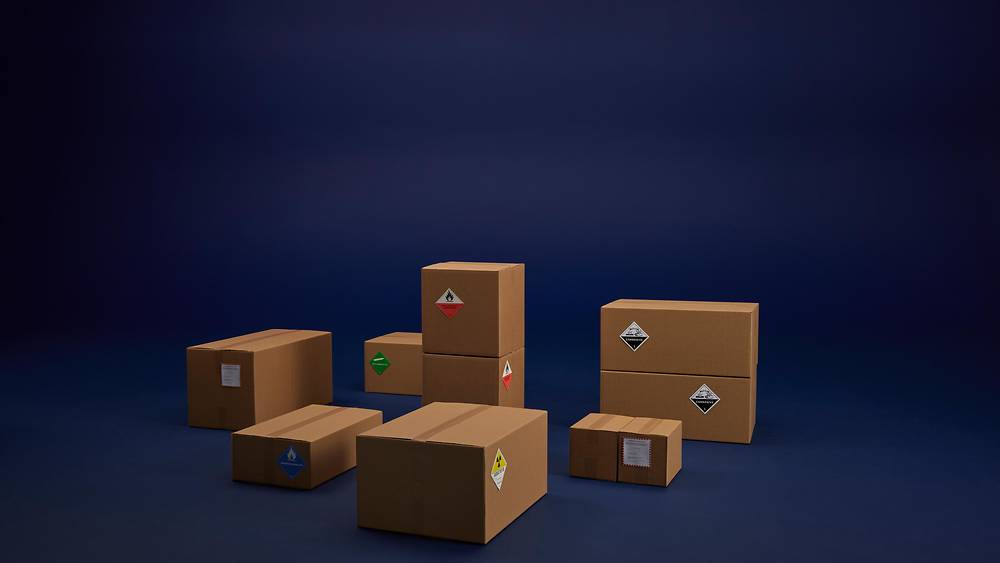Dangerous Goods


Handle with extreme caution
Dangerous goods are articles or substances that are capable of posing a risk to health, safety, property or the environment, and which are shown on the list of dangerous goods in IATA Dangerous Goods Regulations, or which are classified according to those regulations.
Some dangerous goods are too dangerous to be carried by aircraft, others may be carried on cargo airflights only, and some are acceptable on both cargo and passenger aircraft. A number of limitations are placed on dangerous goods that are permitted by air. Both states and operators may impose further restrictions.
Service features
- Correctly identified, classified, packed, marked, labeled and documented
- Good quality packaging that is constructed and closed to prevent leakage
Information and labelling
Shipper is responsible for identifying, classifying, marking, labeling and providing the documentation of dangerous goods. Shipper must also be trained to handle dangerous goods in an appropriate way. Dangerous goods must be packed in packaging of good quality, which must be constructed and closed as to prevent leakage in normal condition of air transport. The packing provisions of DGR Section 5 apply to both new packaging and re-used packaging. Shipper is responsible for all aspects of packing.
The shipper is responsible for all necessary markings.
Unless otherwise provided for in DGR a package or overpack must, as a minimum, be marked with:
- The Proper Shipping Name(s)
- UN or ID Number(s)
- Name and Address of the Shipper and Consignee
In addition to this there are more requirements for:
- UN Specification Packages
- Type A and Type B Packages for Radioactive Materials
- “Limited Quantity” Packages
- Shipments containing several non-identical packages
- Infectious Substances (Division 6.2)
- Radioactive Material (Class 7)
- Refrigerated Liquefied Gas (Division 2.2)
- Carbon Dioxide, Solid (Dry Ice)
- Overpacks
Information on labeling and other DG regulations are available on IATA web page.
- The shipper is responsible for all aspects of packing.
- Most classes/divisions of dangerous goods are divided into three packing groups depending on the relative degree of danger they represent: I high danger, II medium danger and III low danger. This impacts the packing method and packaging specifications.
Dangerous Goods Regulations
Dangerous goods and their maximum quantities, packaging, handling, marking and documentation requirements are specified in detail in the Dangerous Goods Regulations (DGR), published annually by IATA. These regulations are based on the regulations from the International Civil Aviation Organisation (ICAO-TI), which are in turn derived from United Nations recommendations concerning the transportation of dangerous goods for all modes of transport.
When a shipment contains one or more of the dangerous substances from the above list, the carrier requires the shipper to complete and sign a Shipper`s Declaration for Dangerous Goods. This is a legal document declaring that the shipper has complied with all relevant regulations and instructions. It must be completed in duplicate and strictly following the detailed instructions given in IATA DGR 8.1.6.
Attention! If you would like to use the form available from the link, please note that the printout must be in colour (red white hatchings). The form can be completed by clicking each of the fields. Please move the cursor on top of the field to get a short description of the information required.
List of Dangerous Goods
The following are classified as dangerous goods:
Class 1 - Explosive substances
Division 1.1—Articles and substances having a mass explosion hazard.
Division 1.2—Articles and substances having a projection hazard but not a mass explosion hazard.
Division 1.3—Articles and substances having a fire hazard, a minor blast hazard and/or a minor projection hazard but not a mass explosion hazard.
Division 1.4—Articles and substances presenting no significant hazard.
Division 1.5—Very sensitive substances having a mass explosion hazard.
Division 1.6—Extremely sensitive articles which do not have a mass explosion hazard. Usually not acceptable for air transportation.
Some substances/articles in divisions 1.3 and 1.4 are acceptable.
Division 2.1—Flammable gas
Division 2.2—Non-flammable, non-toxic gas
Division 2.3—Toxic gas
Class 3 - Flammable Liquids
Division 4.1—Flammable solid
Division 4.2—Substances liable to spontaneous combustion
Division 4.3—Substances which, in contact with water, emit flammable gases.
Division 5.1—Oxidizer
Division 5.2—Organic peroxides
Division 6.1—Toxic substances
Division 6.2—Infectious substances
Class 7 - Radioactive materials
Class 8 - Corrosive substances
Class 9 - Miscellaneous dangerous substances and articles, including Environmentally Hazardous Substances
Lithium battery shipments containing only lithium-ion batteries (UN3480 & UN3090) are forbidden on passenger aircraft.
The following lithium metal battery shipments are regulated to be forbidden for transport as cargo on passenger aircraft and Finnair does not accept them for transport.
- UN3480 Lithium-Ion Batteries, Packing Instruction PI965 Section IA and IB (RBI)
- UN3090 Lithium Metal Batteries, Packing Instruction PI968 Section IA and IB (RBM)
Shipments of equipment with batteries inside are still accepted for transport.
Other lithium-ion battery shipments prepared according to current IATA Dangerous Goods Regulations are still accepted.
- UN3481 Lithium-Ion Batteries packed with Equipment, Packing Instructions PI966 Section I (RLI) and Section II (ELI)
- UN3481 Lithium-Ion Batteries contained in Equipment, Packing Instructions PI967 Sections I (RLI) and II (ELI)
Other lithium metal battery shipments prepared according to current IATA Dangerous Goods Regulations are still accepted.
- UN3091 Lithium Metal Batteries packed with Equipment, Packing Instructions PI969 Section I (RLM) and Section II (ELM)
- UN3091 Lithium Metal Batteries contained in Equipment, Packing Instructions PI970 Sections I (RLM) and II (ELM)
For further information please contact your local Finnair Cargo Sales/Reservations.